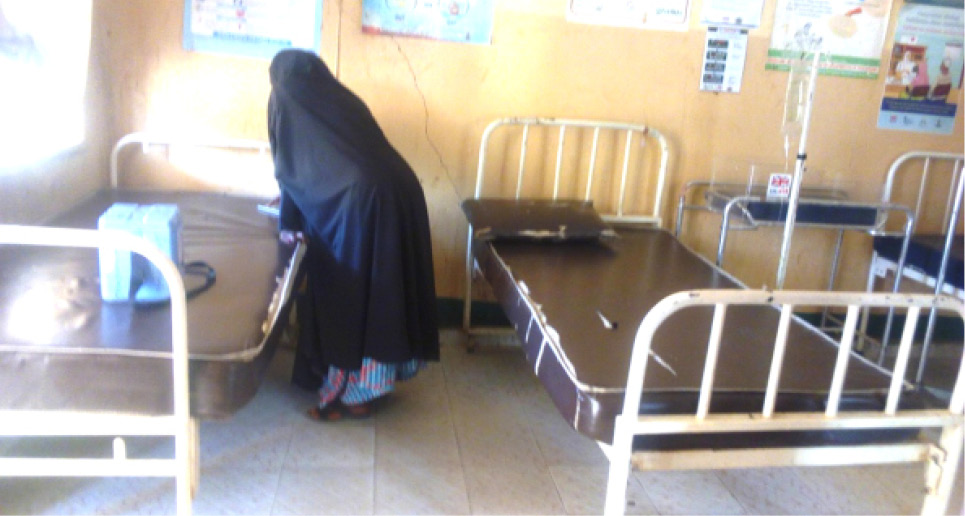For 10 years, the primary health centre in Gidan Goga, an outback in Maradun council area of Zamfara, didn’t hospitalise any patient: it had no beds for admissions; all it had were broken.
A health committee struck up in the community by a nongovernment organisation working to improve maternal, newborn and child health swung into action.
It mobilised a total N30,000 in donations from residents. Instead of buying new bed, the committee got a resident artisan to repair half the broken beds in two exchanges. The first exchange was cash payment for half the beds; the second was the scrap beds.
Binta Dahiru was the first patient to be hospitalised in a health facility with beds.
“Before I would not have allowed myself to be admitted here. I would have rather stayed at home to get the treatment there,” she says.
She is not alone. “Almost everybody would have preferred to stay at home,” she adds.

The change in Gidan Goga is indicative of the work that nongovernment organisations have been doing in Zamfara, filling gaps where government spending is unable to meet health needs.
The World Bank bankrolled a project to help Zamfara meets its health needs, sparking a transformation that’s swept through Zamfara in the first half of 2018.
The project was tagged Saving One Million Lives Initiative Programme-for-Results (SOML).
SOML aims to increase the use and quality of high impact reproductive, child health and nutrition interventions. It awards bonus in millions of dollars to states that show results for money spent on health.
Zamfara joined in, netting more than N9 billion in bonus for improving its health indices in less than a year. But the bonus has become the source of serious contention that threatens the survival of SOML in the state.
Sources inside the programme and development partners in Zamfara have expressed displeasure and annoyance at the changes to SOML in the state. Insiders involved with the programme spoke with Daily Trust, and requested their identities not be revealed for fear of reprisals.
How many lives saved?
Alongside states implementing SOML, Zamfara got $1.5 million last year to start the programme. The money is domiciled with the Central Bank of Nigeria, in a separate account not linked to the state account.
The structure of SOML required the programme be domiciled in the state health ministry, with a programme manager in the state. The programme manager draws up procurement requests, which are approved by the health commissioner or permanent secretary in the health ministry.
SOML allows Zamfara and its partners working in similar fields to work on developing a state work plan to be approved by the federal health ministry.
Across states, the programme works on six pillars:
- Improving maternal, newborn and child health
- Improving coverage of routine immunisation and achieving polio eradication, measured by what proportion of children get a third dose of vaccine for diphtheria, pertussis and tuberculosis
- Elimination of mother-to-child transmission of HIV
- Scaling up access to essential medicines and commodities
- Control of malaria, measured by number of children aged under five sleeping under insecticide-treated nets
- Improving child nutrition.
“One interesting thing about the SOML is that you are given six pillars and asked to development a work plan suitable for your own state, suitable for your own level in terms of health indices,” says Katsina state health commissioner Maryatu Usman.
“When you performance is measured, it is based on your own baseline.”

Zamfara health indices were some of the lowest nationwide. Its baseline at the start of the programme was at the bottom, compared with other states across the country.
Its maternal mortality ratio was 1,049 per 100,000 live births; 60 out of every 1,000 born died in infancy, and by the age of 5 years, a total of 176 of every 1,000 children will have died. A third of all maternal and child deaths was linked to malaria.
Among children aged under five, 19 in 100 were too short for their age, a condition called stunting. Only 21 in 100 children were fully immunised. Just two in 100 women of reproductive age used contraception to space births or prevent unwanted pregnancies. Among women who got pregnant, only 11 in 100 gave birth in health facilities.
For children, only around seven in 100 were exclusively breastfed. Less than two in 100 children slept under insecticide-treated nets. Only 18% of children aged under five diagnosed with malaria were treated using recommended artemisinin-combination therapy.
With $1.5 million, estimated at N540 million, Zamfara looked to “low-hanging fruits” to change its fortunes.
Nongovernment organisations working as state partners already worked in the areas where Zamfara had challenges. Insiders say nearly every health intervention in Zamfara is supported by partners.
Partners, through meetings and workshops, fleshed out a work plan for Zamfara. To get the work plan, NGOs working in Zamfara committed funds to pay consultants contracted by the state and to provide meeting logistics.
In one review meeting, “other states were scoring 75-80% and Zamfara scored only 2%,” a source said.
A forum of health partners met with Zamfara State Governor Abdul-Aziz Yari, and presented the indices, and “the story changed completely,” the source said.
Zamfara’s partners continued their work; the $1.5 million filled in the gaps.

Distribution of insecticide-treated nets continued; mobilisation of women for antenatal care in health facilities, where they could undergo HIV testing before referral if positive, went on; work continued to improve immunisation coverage. The work plan covered all six areas the SOML is concerned with.

But SOML comes with a twist: Zamfara is not in competition against other states with better indices. It is in competition against itself. Its progress is measured by how much it moves from its baseline.
Compared with where it was coming from, Zamfara moved light years. Its baseline was subtracted from its performance, and the difference multiplied by $205,000. It hit gold.
Zamfara had checked all the boxes. Along with Katsina and 10 other states, Zamfara qualified for any disbursement from the SOML.
“The rest did not qualify and were given $1m as loans,” one source close to the programme revealed.
“Whenever they make any improvement, that money will be deducted.”
Zamfara also emerged national champion, netting an additional $1m in bonus. Officials put its total prize at $10.6 million, valued at more than N3.8 billion today.
The money was meant to further Zamfara’s progress, but spending it has become the hot potato that’s divided state officials and partners in Zamfara. Right in the middle is the state government itself and the women and children who comprise the million lives to be saved.
Sour taste and strange bedfellows
SOML targets the primary health care, considered the weakest link in health in Nigeria.
Zamfara’s emergence as a national champion hasn’t gone down well with especially states in the northwest. Officials understand how the review works, and how progress is based on the baseline of individual states.
They also understand each state competes against itself, with progress measured by how much it moves away from its baseline year on year. But Zamfara clinching the title of national champion is a bitter pill.
“We understood the technicality of how that result was arrived at,” said Musa Dutse, state programme manager for SOML in Kaduna state.
“Saving One Million Lives rewards you for improvement, not absolute result. It rewards you for moving from point A to point B.”
But that hasn’t stopped states questioning why Zamfara should emerge national champion.
“Because we understand the technicality, we have said that if the programme will subsequently be reviewed, the way of assessing states should be a little bit changed in such that sates that are performing well will also get some rewards, not that because you are doing so poor, you now get rewarded for improvement,” said Dutse, explaining other states’ view.
Kaduna still works with development partners on SOML. Katsina has taken a different path: previously NGOs, with funding from international donors, designed and executed programmes from start to finish; Katsina has taken on that role using SOML funding.
Local partners feel entirely cut out of SOML work plans and programmes in Katsina, but the state isn’t budging.
Usman, Katina’s health commissioner, says SOML has helped the state build the capacity of its officials to design, implement and monitor programmes, taking on roles in health where other state governments would sit with folded arms.
Money problems
States implementing SOML have moved on since the controversial review that ranked Zamfara champion.
Zamfara itself has stalled and shifted gears from health to politics.
Stakeholders watching SOML have raised concern about the programme’s independence. And development partners, like in Katsina, have been cut off SOML implementation.
By December 2017, Zamfara had N124m in balance from the original $1.5m. The first tranche from the bonus $10.6m it received marked the start of SOML problems in Zamfara.
Some state officials, including the governor, Daily Trust was told, understood the bonus to be a freebie for the state government to spend at will.
With that understanding came a clampdown on implementation.
There are concerns in the state that the money is being held back to fund election campaigns or gratify cronies.
The suspicions arose when Zamfara’s work plan after the review shifted focus from its “low-hanging fruits” to massive construction projects said to have nothing to do with primary health care.
One Zamfara’s SOML plan was to renovate maternity units of primary health centres statewide—one in each of the 147 political wards. Zamfara has 676 primary health centres.
Instead, renovation of three general hospitals entered the work plan. Before SOML, the state government had already renovated general hospitals in seven locations.
Officials, in defence on adding renovation of general hospitals to SOML plan, said it was to key into the federal government’s drive to revitalise one primary health care in each ward.
The renovation was to go on alongside renovation of entire primary health centres, instead of maternity units as had been previously planned. Zamfara allocated N5.5m per facility.
At that cost, it was decided the budget would only cover the complete renovation for 30, using SOML funding, leaving out 117.

The cost of renovating the balance 117 facilities would be borne by the state government.
It meant SOML funding would move from primary health care to renovate general hospitals in Kaura Namoda, Gurmi, and Tsafe, as well as upgrade another general hospital at Talata Mafara—where the state government is looking to site a university—to a teaching hospital, sources say.
An official in the ministry of health defended the construction as having positive impact on the state’s indicators.
“If a facility is dilapidated, you won’t want your wife to deliver there, you won’t want to carry your child there. That’s why we want to improve on the infrastructure that has decayed over years of neglect,” the official said.
Partners working on SOML in Zamfara say the large-scale constructions were arbitrarily inserted into the work plan against due process. There were no bids for contracts; instead bills of quantity were conjured and inserted, they told Daily Trust.
SOML was still running on the balance N124m from the first $1.5m before its bonus came in. The first tranche of the bonus was 25% of $10.6m.
“Suddenly the commissioner said the governor said we should stop spending,” a source closely involved in developing the state’s work plan said.
“Why? He said we had started touching that money—the one that came in second tranche [the first tranche of Zamfara’s reward.]
“Their belief is that that money is a reward given to the state to do whatever it wants.”
Analysts looking into Zamfara’s work plan for 2018 say up to 80% of SOML funding has been budgeted for activities that have no impact on primary health care and contribute nothing to the indicators on which Zamfara will be assessed at the next review.
For instance, progress in malaria control is measured in terms of net distribution. “But you can now see them chipping in programmes like seasonal malaria therapy, which requires procurement,” said a source.
The commissioner mentioned is Lawal Liman, who emerged chairman of the All Progressives Congress in Zamfara in May. By civil service rules, he also should have quit his position as commissioner when he went into politics.
Effectively, Zamfara did not have a health commissioner, and no one else was named after Liman’s move into politics. But sources say he kept control of the health ministry even after entering active politics, though not showing up at work.
SOML was officially embroiled in the politics of Zamfara, as the country veered into election fever.
“Zamfara’s own politics is different. It is only in Zamfara that we don’t have contestants yet,” the source at the health ministry said in October.
“We couldn’t do election. In implementation now, we haven’t done much. That’s since around August. As for activities, we haven’t done much.
“The partners are not happy. Nobody is happy. You have been doing something yielding result. You have no reason to deviate from that system and then adopt another one,” said the source.
“The fear is some people politicians will be appeased by award of contracts. There are lots of issues people are not happy with.”

Explanations offered follow a narrative: the first tranche of the bonus was not enough to pay for the renovation planned. With the N124m left over from the first $1.5m still running, the state government expected SOML would get a regular $1.5m every year.
Any additional fund over the $1.5m was for the state government, which had a right over the incoming bonus. In fact, any additional funds to SOML were a favour from the state government.
But when the first 25% of $10.6m bonus was not enough to pay for planned contracts, the order came to halt SOML.
Sources say the order to stop the programme was never communicated in writing. But the programme halted nonetheless.
The state programme manager Sabitu Tsafe would not respond to questions about the programme.
“The first money we receive is about 25% of the total money which is not enough for the renovations at hand. As a result, we suspended all the activities,” an insider said.
“If for instance the total money earmarked for renovation of three general hospitals is 1.9 billion naira, and you have 1 billion naira, you should give us. There is no need to wait till you have N900 million before we carry out the renovations.
“Does it mean during that time, we won’t be doing anything? Let’s do everything concurrently.”
Another source close to Zamfara’s work plan said, “I believe they just want to mismanage the money and go but our problem in Zamfara is that nobody wants to talk.”

Daily Trust in November reached Suleiman Gummi, the former health commissioner under whom SOML started, to get his sense of SOML implementation.
Gummi had handed over to Liman after a cabinet shuffle in January. He said since handing over and leaving the ministry, he “couldn’t give account”.
“I handed over the affairs of the ministry for the past eight months. It is not fair for me to give account of that ministry,” he said.
Days later, Daily Trust reached Liman, who head Zamfara health ministry when SOML was halted.
He said, “Better speak to the permanent secretary. I’m not in a position to speak to you now on that. Let me talk to the permanent secretary to talk to you. I will call him.”
Daily Trust had previously in October visited Zamfara and spoken with Habibu Yalwa, the permanent secretary of the state health ministry. He said he had no permission to comment on SOML, insisting the commissioner—already months away in politics since winning APC state chairmanship in May—was the face of the programme.
He noted up until then, no replacement had been named for Liman, nor did he definitively resign his position as commissioner.
And that stalls the programme, inasmuch as it needs administrative approval.
Daily Trust asked whether the state government controls SOML, even though SOML funds are separate from Zamfara’s coffers.
The insider at the health ministry replies a resounding yes. “Who appoints the commissioners? Who are the approving officers for SOML? The commissioners and the perm secs are the approving officers. If you don’t have approval, what do you do?
“In as much everything you have to do, you have to write and obtain approval and that approval is not forthcoming, what do you do?” he said.
“But there is no commissioner,” Daily Trust replied.
“He gave the directives,” the source responded.

Zamfara’s SOML raises questions: how much control the state has over SOML funding and decisions and how much the national office of SOML in the federal health ministry have over work plans it approves for states.
Daily Trust had been in touch with SOML national coordinator Ibrahim Kana but reached him with further questions about the programme’s independence while he was away in Washington, DC.
He responded to the first question. “We approve plans for the states but not necessarily telling them what to do. The main focus of the programme in terms of funds flow is restructuring its flow, allowing states take substantial decisions with responsibility. However, we reserve the right to prevent states from spending their funds on areas we know are not going to influence [primary health care]. This happened at various times when states want to build big hospitals or diagnostic centres. We also reserve the right to send auditors to them.”
To the second question, he responded: “The fact that the state does not have a commissioner doesn’t prevent them from working. We operate with the system and not persons or individuals. We expect the permanent secretary to convene a steering committee meeting and forge ahead. After all, [following] transitions, there are no commissioners, so it is not new.”
Hauwawu Mohammed and Jummai Abubakar works at a primary health centre at Tudun Wada, right in the heart of the capital, that caters to thousands who live around it.
On average, up to 40 women attend antenatal clinic there weekly, and three give birth every day.
The maternity room contains two beds donated by a nongovernment organisation. Four other beds are used in one ward. A second ward has no bed at all.
Drugs in the centre’s pharmacy come in two kinds: one sourced free from the anti-malaria partners and another subsidised on a revolving fund model.
Both women feel their patients are better off, they say on a visit to the centre.
Across health centres, dilapidation in the face of millions of naira that can make a difference is apparent, says one source, who works with a development partner in the state.
“As it is now, it is only in Zamfara that if you go to most of our facilities sometimes the officers in charge of those facilities especially those local government areas, they have to be pursuing animals,” she said.
“In so many places, you will see delivery beds supported by stones in Zamfara State. In most cases, a woman will be in labour and rain will be dripping on her forehead. And we have the resources, but we are not willing to address it.”

 Join Daily Trust WhatsApp Community For Quick Access To News and Happenings Around You.
Join Daily Trust WhatsApp Community For Quick Access To News and Happenings Around You.


